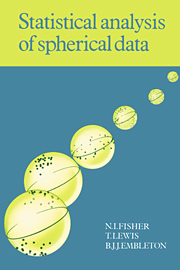Book contents
- Frontmatter
- Contents
- Preface
- 1 Introduction
- 2 Terminology and spherical coordinate systems
- 3 Descriptive and ancillary methods, and sampling problems
- 4 Models
- 5 Analysis of a single sample of unit vectors
- 6 Analysis of a single sample of undirected lines
- 7 Analysis of two or more samples of vectorial or axial data
- 8 Correlation, regression and temporal/spatial analysis
- Appendix A Tables and charts
- Appendix B Data sets
- References
- Index
Preface
Published online by Cambridge University Press: 06 January 2010
- Frontmatter
- Contents
- Preface
- 1 Introduction
- 2 Terminology and spherical coordinate systems
- 3 Descriptive and ancillary methods, and sampling problems
- 4 Models
- 5 Analysis of a single sample of unit vectors
- 6 Analysis of a single sample of undirected lines
- 7 Analysis of two or more samples of vectorial or axial data
- 8 Correlation, regression and temporal/spatial analysis
- Appendix A Tables and charts
- Appendix B Data sets
- References
- Index
Summary
The purpose of the book
The analysis of data in the form of directions in space, or equivalently of positions of points on a spherical surface, is required in many contexts in the Earth Sciences, Astrophysics and other fields. While the contexts vary, the statistical methodology required is common to most of these data situations. Some of the methods date back to the beginning of the century, but the main developments have been from about 1950 onwards. A large body of results and techniques is now disseminated throughout the literature. This book aims to present a unified and up-to-date account of these methods for practical use.
It is directed to several categories of reader:
to the working scientist dealing with spherical data;
to undergraduate or graduate students whose taught courses or research require an understanding of aspects of spherical data analysis, for whom it would be a useful supporting text or working manual;
to statistical research workers, for reference with regard to current solved and unsolved problems in the field.
Because of the range of readership, priority has been given to providing a manual for the working scientist. Statistical notions are spelt out in some detail, whereas the statistical theory underlying the methods is, by and large, not included; for the statistician, references are given to this theory, and to related work. In particular, only one procedure is given for any specific problem. In some cases, the choice of procedure is dictated by certain optimality considerations, whereas in other cases a somewhat arbitrary choice has been made from several essentially equivalent procedures.
- Type
- Chapter
- Information
- Statistical Analysis of Spherical Data , pp. xi - xivPublisher: Cambridge University PressPrint publication year: 1987

